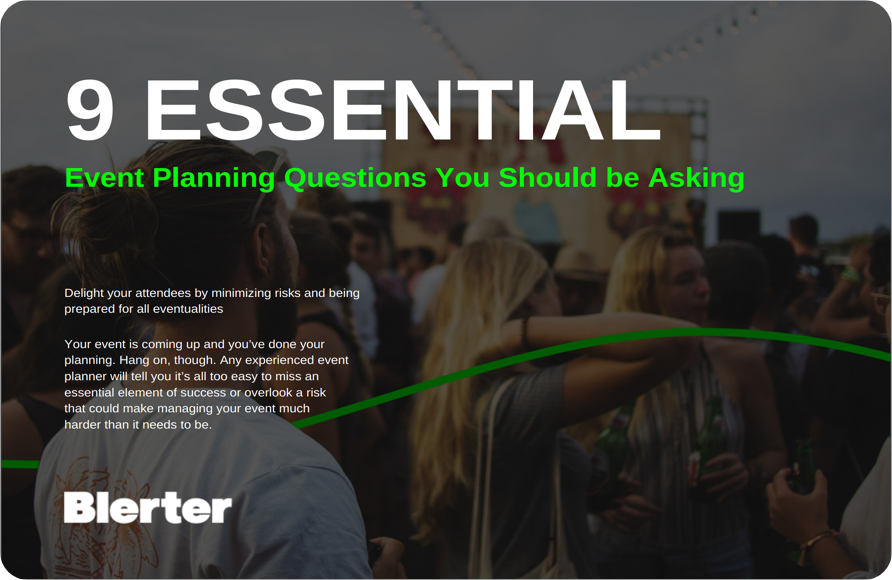“An ounce of prevention is worth a pound of cure” - Benjamin Franklin
No matter how much preparation goes into an event there are always going to be things that don't to plan. How you deal with them can make the difference between small incidents and big issues.
For any event, risk management is an essential part of the planning process to ensure you’re able to respond quickly and appropriately. Know your risks, develop the right strategies to eliminate or mitigate them, and you’re well on your way to creating a safe and secure event.
We know the responsibility of keeping staff and attendees safe can be enough to keep even the most experienced event professionals awake at night. One method to help put your mind at ease is to establish a duty of care program. In this article, where Kevin Iwamoto outlines the steps for creating one, he summarizes your responsibilities as an event planner:
“Today’s meetings and events managers have to be ready for all sorts of unexpected situations that can crop up anywhere… When an emergency happens, you need to be able to communicate with internal departments, meeting attendees, and other affected staff and guests, and most importantly, coordinate assistance. Each minute of inaction can lead to tragic circumstances, even loss of life.”
You shouldn’t be overwhelmed by these responsibilities though. It’s impossible to eliminate all risk, but you can sleep easier if you plan well, put processes in place, and follow the right professional guidance.
Do you want to get to that point where risks are minimized, or even eliminated, and you’re ready to deal with any problems that are thrown your way during the event? Then the first step is to accept that risk management is your responsibility, and not something that can be left until the last minute. Sounds a bit scary, right?
Don’t worry, you’re not alone in this. The good news is that there are risk management experts who cater to all types of event types, and developing a risk management process that’s right for your event doesn't have to mean forging a brand new path without a compass.
Carl Pritchard of Pritchard Management Associates, author of Risk Management Concepts and Guidance, is one such expert and describes some simple options for getting started. One of these is The Project Management Institute’s “simple-to-follow” six-step framework for managing project (or event) risk.

Pritchard also notes similar 6 step processes taught and followed by the US Military and Australian government:
US Military Defense Acquisition model –
Australian Government’s Department of Commerce model –
Source: Carl L. Pritchard, Risk Management Concepts & Guidance (5th ed.) pg. 4-5; 2015 Taylor & Francis Group LLC, Boca Raton, FL, USA
These processes are primarily focused on project management rather than being designed for events, but the steps are applicable to the event context and a good starting point when starting your risk management journey.
If you're looking for a process directly applicable to event planning then you could check out Eventeducation.com. They offer a guide to developing an event risk management plan in six steps:
The process you follow will vary depending on the nature of your event and what works best for you and your team. But the key to a fast response to accidents and issues is following a robust risk management process. If you put the work into developing this process, you and your team will be able to react quickly and minimize the impact of even the most unlikely or unexpected incident.
 When we mention risk, most people immediately think of security, safety and health matters. However, just as important to your success in the events industry is understanding your commercial and reputational risk as well.
When we mention risk, most people immediately think of security, safety and health matters. However, just as important to your success in the events industry is understanding your commercial and reputational risk as well.
Some of the key areas you should be reviewing in the planning stages are given here:
Hint: spending a little more time identifying hazards and their associated risks, then putting controls in place to manage them, could save you a lot of critical time when dealing with them during your event. Something as simple as a “wet floor” or “low ceiling” sign could prevent your attendees (who may be too busy having fun to be fully aware of their surroundings) from suffering an injury.
Hint: an experienced security consultant will be able to identify potential weaknesses in a venue’s security or anticipate crowd behavior so that you’re ready and able to respond to threats, should they arise.
Hint: it might not only be how you respond to accidents, customer complaints, etc., but also how you communicate that determines whether your event’s brand is damaged by an accident or failure.
Hint: depending on what your event involves and where it takes place, sporting bodies, venue management, city councils and specialist consultants might all be able to help you with specific advice on regulations applicable to your event and any permits you might need. Seek the right advice to ensure your event complies with all relevant codes and regulations.
 We’ve covered the areas you need to take a good look at when assessing the risks at your event, but it’s important to remember that every event has its own nuances so one size doesn’t fit all. You must consider all the idiosyncrasies of each individual event when developing risk management plans.
We’ve covered the areas you need to take a good look at when assessing the risks at your event, but it’s important to remember that every event has its own nuances so one size doesn’t fit all. You must consider all the idiosyncrasies of each individual event when developing risk management plans.
A well-considered plan, which ensures that you can respond to incidents quickly and efficiently, will consider a number of factors when prioritizing risks and planning responses.
The nature of the event – A town fair catering to local families, with opportunities to dunk local identities and indulge your children with sweet treats and face painting, involves very different risks to a sporting event, a festival catering to an adult audience or rock concerts where alcohol is served.
Location of the event – Our town fair across the street from the local firehouse and police station involves very different preparation to a ski race or freestyle event at a ski resort many miles from a hospital or EMT assistance. But the ski resort event may actually require fewer medical responders to be employed if the resort has trained ski patrols that they are happy to assign to your event.
Size of the event venue – An event like the Olympics or a lengthy cycle race, spread across many locations, will involve more complicated risk management and more strategic oversight than a small single venue event like a local folk music festival.
Size of the event / crowd – It might be a surprise to hear that some experts suggest “crowds are not of themselves a risk to public safety.” But a recent article in Perspectives in Public Health makes an important distinction. It suggests that it is the movement of crowds that create safety risks. So, risk mitigation with respect to crowds is related to the ease of movement your venue allows and the space your crowd will have to move in. Abiding by maximum numbers at enclosed venues and having removable barriers at thoroughfare pinch-points can reduce risk of injury by managing crowd flow and density.
Communication – Ease of communication is essential when it comes to responding to incidents. In short: the faster you inform the right people of an issue, the faster it can be addressed. Therefore, as part of risk management planning, it’s important to identify any factors that may impede communication, from incompatible communication methods between suppliers to insufficient means of communication. Something as simple as ensuring that staff at all entrances can be kept up to date with crowd numbers and schedule changes can make a world of difference.
Transport – for larger events the way you get attendees from point A to point B can be a key to reduced risk and a more enjoyable experience. As an example, a park and ride system might reduce congestion around entrance ways and allow for safer and more efficient entry to your event.
Weather – from extreme events, like hurricanes, that can mean your event can’t go ahead, to rain or heat, the weather can be an important risk factor. Hot weather could mean offering free water and shaded areas to avoid heat exhaustion. The most important element in your planning is knowing ahead of time how and who you need to make the tough decisions in the heat of the moment, what information they will need and how each decision will be implemented.
Audience – depending on the nature of your event, the nature of your audience can profoundly influence your risk management and response strategies. A rock festival audience may mean your crew need training to spot the signs of drug use or alcohol misuse, whereas spectators and athletes at a summer triathlon may be more at risk from heat exhaustion and dehydration.
Volunteers – Well trained volunteers can help mitigate a wide range of risks, but it is essential that they are prepared for emergencies and know how to respond appropriately. They might not be able to resolve issues themselves, but they need to know what to do in the moment, who to contact and how to contact that person in a secure way.
Suppliers and exhibitors – It’s unlikely you can meet all the needs of your event without third-party help. You might need help from a temporary fencing company to define your outdoors event’s boundaries, ticketing systems to sell tickets, security to manage the gates, caterers to prepare food, bar staff to serve drinks. Your event might be hosting exhibitors promoting their products or attractions selling experiences to your attendees. Risks abound – from food poisoning and poorly trained bar staff allowing attendees to overindulge, to poorly maintained rides and ticketing systems that allow easy forgery and overcrowding of your event. But good suppliers could also make your life easier by having effective risk management and response strategies themselves. The key to successful emergency response will be effective integration of these external parties into a broader team.
Emergency services – Responding to accidents and incidents is what these people do. Their expertise is invaluable. But your challenge is to ensure you have enough emergency service help and a way to call on them quickly in times of need.
Planning and communication - without them, you won’t have an effective risk management system in place and you won’t have the means to deal with the unexpected on event day.
The International Standard Organization recently updated their guidance on risk management, ISO 31000:2018. It defines risk as “the effect of uncertainty on objectives” and the ISO encourages organizations to “tailor risk management to their needs and objectives”. It also recommends a few key principles to follow, such as continual improvement and including all stakeholders in the process.
These principles are directly applicable in the context of effective event risk management that minimizes the impact of potential hazards. It’s worth taking the time to implement and follow them.
Planning for your event should always include a process that covers off areas of risk and factors that influence that risk. The more complex your event, and the larger the number of parties involved, the more careful planning is required. And remember, effective communication on the day will be the key to your ability to respond quickly when things go wrong.

Streamline your delivery, be prepared for things that can go wrong and increase crew engagement at your next event.